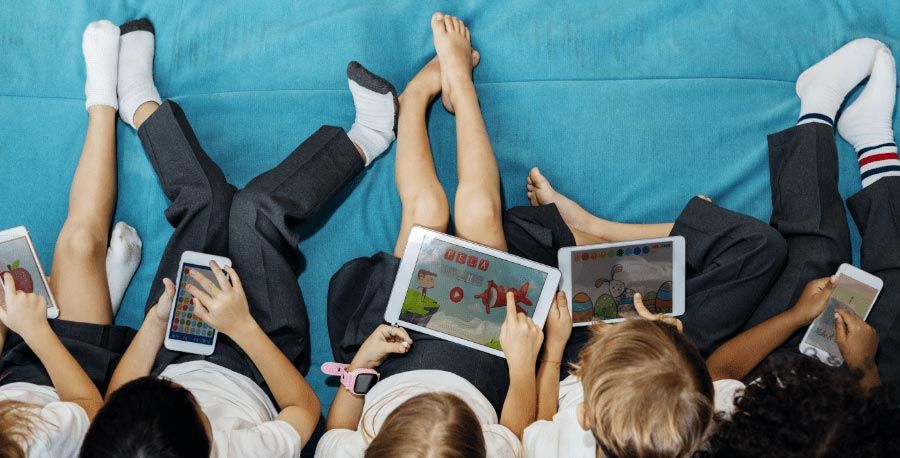It’s no secret that computers, tablets, cell phones, and video games have become staples in our children’s everyday lives. So how does this affect our children? The truth is that most children are spending too much time on screens, which can lead to poor eye development and increases your child’s risk of developing certain eye conditions, such as myopia and digital eye strain. Keep reading for some tips for parents about how to protect your child’s vision:
Myopia
All that extra screen time, whether games, videos or reading on their handheld devices, can be a risk factor in the development and progression of something called myopia or near-sightedness.
When your child’s eyes stare at something too close, their brain and eyes adjust or “accommodate” to increase close-up vision. This can cause dramatic changes in eye function, especially in a child’s eye that’s not fully developed.
Children with myopia or other vision problems may not feel as confident at school, or during sports and play time because they are not seeing as comfortably or clearly as they could. There are also long-term serious eye health consequences for myopia, such as cataracts, retinal detachments and myopic macular myopathy which can lead to severe vision impairment.
Digital Eye Strain and Eye Fatigue
Digital eye strain is increasingly common among children, and it can cause headaches, eye fatigue and blurry vision. Children who spend more time on digital devices are at higher risk for these symptoms.
The tricky part is these devices are designed to keep your child engaged, and your child may not tell you when they are experiencing any symptoms since they are having so much fun. You may need to remind them to take frequent breaks from their screen and to look at something in the distance. We call this the 20-20-20 rule. Every 20 minutes, look up from your screen and focus on an item approximately 20 feet away for at least 20 seconds.
Eye care professionals also recommend that parents should limit their kids’ screen time to less than two hours per day.
Dry and Irritated Eyes
Dry, itchy, irritated eyes can be the result of the eye not getting enough moisture and may be due to not blinking enough. We blink significantly less than we are supposed to when looking at a screen for an extended period of time which can lead to dry, irritated, and sore eyes.
Taking breaks, using lubricating eye drops, and adjusting screen brightness and distance can help to increase how often your child is blinking.
Sleep Disruption
Digital devices emit something called blue light. Blue light is a portion of the light spectrum that can influence alertness, hormone production, and our circadian rhythm. The use of electronic devices prior to going to sleep makes it not only more difficult to fall asleep, but also disrupts sleep during the night, causing poorer quality sleep. This is particularly problematic for children, as they require much more sleep than adults to aid in their mental and physical development.
Even a half-hour less of sleep can negatively impact their behavior the following day and can result in things like drowsiness, trouble focusing at school, moodiness, poor coordination, memory troubles, and other physical problems.
Symptoms to Look Out For
If your child is experiencing any of the following symptoms, they may be suffering from a screen-related vision problem:
- Sore, tired or burning eyes
- Complaints of blurry vision
- Watery or dry eyes
- Difficulty concentrating on tasks
- Complaints of headaches
- Squinting or closing one eye to focus on an object
- Sensitivity to light
- Sitting close to their devices
So, What Can You Do?
We know how much you love and care about your children. You want the best for them! Here’s some easy steps you can take to help your children avoid the harmful effects of screen time:
- Be realistic! Screen time should be limited to less than 2 hours per day, but if your kids spend a lot of time on screens currently, start by setting smaller, more attainable goals. Try cutting their current screen time in half.
- Turn off screens at least an hour before bedtime and put devices away so they’re not attracting your kid’s attention.
- Take regular breaks! Encourage them to do something else instead. Go outside for fresh air, play with friends in person rather than online, or read a book! Follow the 20-20-20 rule.
- Make sure they don’t sit too close while using these devices, and remind them to take long, full blinks.
- Talk to them! After school or work, spend time each day talking face to face with kids and give them your full attention. What was one thing about their day they really loved?
- Schedule regular eye exams. We recommend that your child sees an eye doctor once at 6 months of age and yearly thereafter, or more frequently if you are having any concerns.
We hope you found this information helpful! We know that it can be difficult for parents to keep up with their kid’s digital devices and ensure they are being used safely, but we are here to support you every step of the way. If you have any questions about the effects of screen time on your child’s eye health, book an appointment with your eye doctor to have your child’s eyes examined and discuss possible preventative measures or treatment methods.















